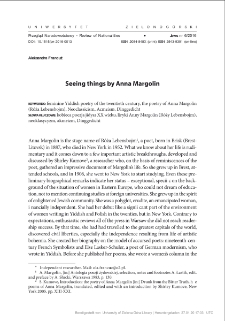Digital Library of Zielona Góra contains 65 391 digital objects
Object
Title: Seeing things by Anna Margolin = Widzenia rzeczy Anny Margonin
Contributor:
Group publication title:
Abstract_pl:
Jeśli przywołać najważniejsze dla tej poezji słowa, należałoby rozpocząć opowieść od kamieni, lilii, dłoni i krwi, które, jeśli przyjrzeć się im z filologiczną dokładnością, są wzajemnie powiązane: sytuują się wyraźnie na przeciwległych brzegach procesu twórczego. ; Mówią o wznoszeniu gmachu złożonego z wyobrażeń o sile i słabości swej, upojeniu i zastyganiu w tym, co od wieków poeci klasycy próbowali zgłębić: harmonię i jasność, wiedzeni nadzieją, że w życiu ponad wszystko trzymać się należy piękna. A ponadto w dyscyplinie nie poprzestawać, ćwiczyć oko i poszerzać pole widzenia, od porywów serca nie stronić; serce bowiem rośnie, potężnieje od wielkich idei, namiętności. ; Pojemna się staje ta wizja pisania, jest splotem sprzeczności - tak ją widzi jedna z najważniejszych poetek dwudziestowiecznych, pisząca w jidysz, Anna Margonin. Poezja Margolin jest wyraźnym zwrotem w stronę neoklasycyzmu, nawarstwianiem wątków, tez, aluzji, myśli przejętych od światopoglądowo jej bliskich artystów, wielkich indywidualności: Anny Achmatowej (od której przejęła imię), Osipa Mandelsztama, Rainera Marii Rilkego, Ezra Pounda.
Abstract:
If we recall the most important words for the poetry, we should begin the story with the stones, lily, hands and blood, which, if you look at them with the philological accuracy, are interrelated: situate themselves clearly on opposite banks of the creative process. ; They talk about the construction of the building consisting of perceptions about their own strength and weakness, ecstasy and congealing in what for centuries the classics poets have tried to fathom: the harmony and clarity, driven by the hope that in life they should above all stick to be beauty. And in addition, they ought to go further than discipline, practice eye and expand the field of view, should not shun from the gusts of the heart, because the heart grows more powerful due to great ideas, passions. ; Spacious becomes the vision of writing, it is the weave of contradictions - this is how one of the most important twentieth-century poets, who wrote in Yiddish, Anna Margolin sees it. Margolin?s poetry is a clear return towards neoclassicism, building up topics, theses, allusions, ideas taken from ideologically close to her artists of great individuality, Anna Akhmatova (from whom she took her name), Osip Mandelstam, Rainer Maria Rilke, Ezra Pound.
Publisher:
Zielona Góra: Oficyna Wydawnicza Uniwersytetu Zielonogórskiego
Format:
Resource Identifier:
DOI:
Pages:
Source:
Language:
License:
License CC BY-NC-ND 3.0:
Rights:
Biblioteka Uniwersytetu Zielonogórskiego
Object collections:
- Digital Library of Zielona Góra > Repository > Faculties > Faculty of Education, Psychology and Sociology
- Digital Library of Zielona Góra > Repository > Types of work > Articles
- Digital Library of Zielona Góra > Repository > Scientific journals and UZ publishing series > Review of Nationalities
Last modified:
Aug 11, 2023
In our library since:
Aug 11, 2023
Number of object content hits:
128
All available object's versions:
https://zbc.uz.zgora.pl/publication/82615
Show description in RDF format:
Show description in OAI-PMH format:
| Edition name | Date |
|---|---|
| Seeing things by Anna Margolin = Widzenia rzeczy Anny Margonin | Aug 11, 2023 |
Objects Similar
Kucharczyk, Anna Kuczyński, Tadeusz - red.

